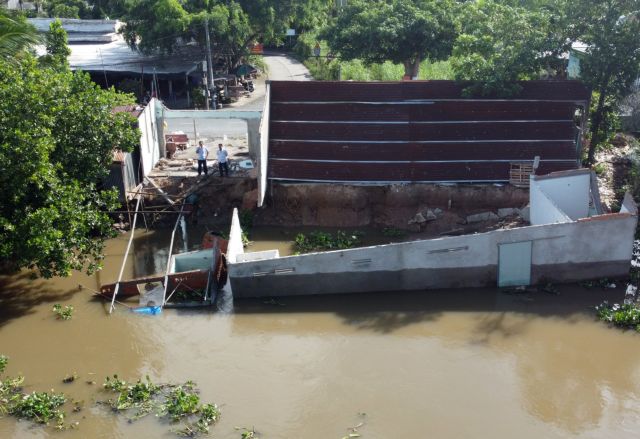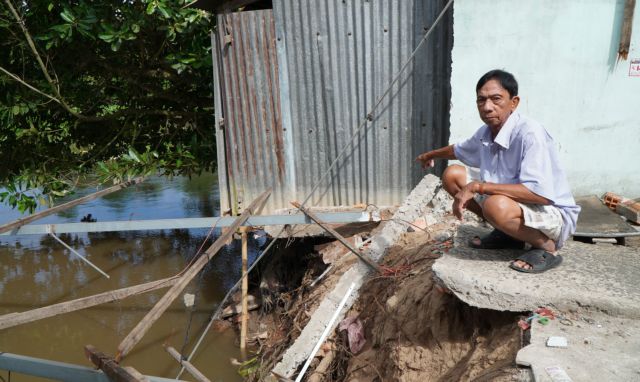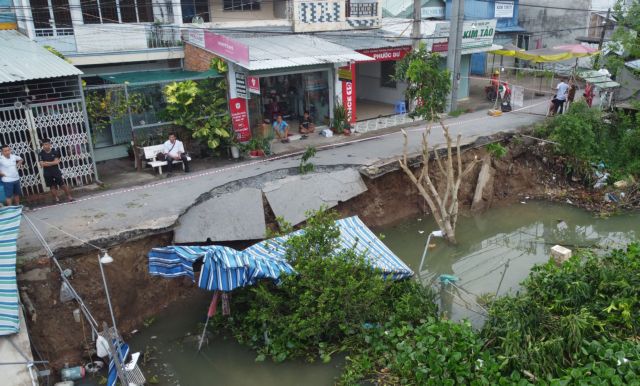 Environment
Environment

 |
| The house of Võ Văn Dũng, a resident of Nhị Mỹ Commune in Cao Lãnh District collapsed and fell into the Cần Lố canal due to erosion in late May. VNA/VNS Photo Nhựt An |
The house of Trần Ngọc Điệp, a resident in Tân Nhuận Đông Commune of the southern province of Đồng Tháp, is at risk of collapse any time due to river erosion.
“The situation is so dangerous that I wouldn’t dare to sleep in my home, I had to sleep at a relative’s house,” Điệp said.
“I’m in financial hardship and hope that the local government support me with a place to live that is more secure,” he said.
Erosion occurred in many areas of Đồng Tháp Province, turning people’s lives upside down, and putting them at constant risk of their homes collapsing.
Early this month, there was an erosion 30 metres long on the Nha Mân - Tư Tải river bank (Tân Nhuận Đông Commune, Châu Thành District). It seeped into the land by 4-5 metres, causing problems on route DT854 which connects Châu Thành District with Bình Tân District in Vĩnh Long Province).
There were no injuries reported, but the erosion sank a warehouse of agricultural supplies and a motorcycle repair shop of two local households. The estimated damage is around VNĐ500 million (US$21,200).
In late May, erosion occurred in Cần Lố river bank in Nhị Mỹ Commune, Cao Lãnh District, causing VNĐ500 million damage.
The erosion was 40 metres long, seeping into the land by 3-5 metres, damaging two houses, causing 160 square metres of land to fall into the river.
A week earlier, on the same Cần Lố river bank near Nhị Mỹ market, another 30 metre long erosion occurred, sinking 135 square metres of land and putting five houses at risk.
Vice Chairman of the People’s Committee of Cao Lãnh District, Huỳnh Thanh Sơn said that in order to ensure safety for the citizens and preventing erosions, they will be requesting the help of the provincial Steering Committee of Responding to Climate Change - Natural Disaster Prevention and Search, Rescue.
Huỳnh Minh Đường, Director of Irrigation Division said, since early 2023, there have been 19 erosions on rivers, canals, ditches in the communes: Phương Trà, Tân Hội Trung, An Bình, Tân Nghĩa, Nhị Mỹ, Mỹ Thọ (Cao Lãnh District); Tân Phú Đông, Tân Quy Tây (Sa Đéc Town); Hòa Tân, Phú Long, An Khánh, Tân Nhuận Đông (Châu Thành District).
The total length of the erosion amounted to 600 metres with total size of 2,000 square metres.
 |
| The warehouse of agricultural supplies and a motorcycle repair shop were submerged due to erosion in Nha Mân - Tư Tải canal in Tân Nhuận Đông Commune early this month. VNA/VNS Photo Nhựt An |
A total of five houses collapsed and 15 other households were affected directly with total estimated damage of VNĐ2 billion.
Notably, he said, within two months (from late March to early June), Cao Lãnh District alone has dealt with 12 erosions, totaling 345 metres in length and 1,285 square metres total area, forcing many families to dismantle their houses and relocate.
According to Đồng Tháp Province’s Steering Committee for Climate Change Response, Natural Disaster Prevention and Control, Search-Rescue, in 2022, the erosions in Tiền and Hậu rivers had a total length of 27 kilometres, seeping into the land from 0.3-22 metres in 21 communes, wards, towns of eight districts and cities.
A total of 3.2 hectares of land was lost, properties damage was estimated to be VNĐ7 billion,
As many as 19 households were affected and were relocated.
Last year the province also had to deal with erosions on canals and ditches with a total length of 21.7 kilometres (increased by 19.5 kilometres compared to 2021) with total damage estimated at VNĐ6.37 billion (increased by VNĐ5.12 billion compared to 2021).
Causes and response
Vice Director of the Department of Agriculture and Rural Development of the province Võ Thành Ngoan said that the main reasons for erosion include the impact of water’s momentum, and changing of water flow caused by the emergence of sand dunes in the river bed.
 |
| Erosion in Đồng Tháp turns locals' lives upside down. VNA/VNS Photo Nhựt An |
Erosion tends to happen in isle areas, where rivers branch out, places where streams merge in, where water streams are unstable, or streams are narrow, and where rivers lack alluvium.
Human activities also contribute to the issue including unplanned aquatic animal farms; building houses and other constructions that take over a part of the river’s surface. Climate changes (including land subsidence and rainfall changes) also contribute to landslides in the province’s river bank areas.
The river bank erosion is also caused by riverbed and canal dredging activities. Most of the traffic infrastructure works in rural areas are located close to the river banks, he said.
To prevent erosion, local authorities have strengthened management of sand exploitation activities, construction near rivers, canals and ditches.
In the last few years, through support from the central government, Đồng Tháp has carried out many projects with budget up to trillions of đồng in order to prevent erosion. Many embankment constructions have been built, such as: Hồng Ngự, Sa Đéc, An Hiệp (Châu Thành District). Furthermore, locals are carrying out embankment projects in Cao Lãnh City, Thanh Bình District and Lấp Vò District.
 |
| Erosion on May 12 this year in Nhị Mỹ Commune, Cao Lãnh District. VNA/VNS Photo Nhựt An |
The province also suggested local residents grow types of plants that can maintain soil and protect river banks, canals, ditches; including bần (Sonneratia caseolaris)– a kind of plant that local residents are quite familiar with.
According to Chairman of Tân Quy Tây Commune’s People’s Committee Phan Thanh Vũ, local residents in his commune have grown bần trees for eight years.
“In general, planting bần to maintain soil is an effective strategy. The commune has been planting about 2,400 bần near Ông Hộ Canal and a few more canals,” he said.
Many other localities in the province are also planting bần trees to prevent erosion. Cao Lãnh District will implement a project to plant 38,000 bần trees in July 2023; Lai Vung District has planted 5,000 bần trees along canals and canals at risk of erosion. In 2023, the province aims to plant about 120,000 bần trees. — VNS




